Saurenman Aero Works REVO
Lean, mean aerobatic machine.
Rewind to April 2016 when we attended Sun ’n Fun for the very first time and stumbled across a mockup shell of a rather intriguing and thought-provoking Experimental composite aerobatic aircraft. The Saurenman Aero Works (SAW) REVO left both of us asking questions, pondering the viability and performance of such an aircraft and thinking, “We’ve got to keep our eyes on this design!”

Now fast-forward six years to Air-Venture 2022. Lo and behold, that mockup is no longer just a mockup! Front and center at International Aerobatic Club (IAC) headquarters, displayed on the lawn to the right of the main entry, was SAW’s first flying REVO prototype. We were even lucky enough to speak with the designer, Eddie Saurenman, and his family.
The Man
Eddie was raised in an aviation household and was building his first aircraft at age 14. When he was a teenager, he funded his flying habit by having multiple part-time jobs, such as building 15-meter composite sailplanes for Aerotek in Albuquerque, New Mexico, and washing cars at a local dealership. When the Pitts S1 he was flying came up for sale, he was able to swing a bank loan as a 17-year-old through his sheer persistence and determination. He waited outside the bank for the doors to open for business for the day, with paperwork vouching for his character and cosigned by the sales manager of the car dealership he was working at, along with George Applebay of Aerotek. Needless to say, his enthusiasm impressed the loan officer, who went to bat for him. His loan request was approved and he managed to buy that Pitts.
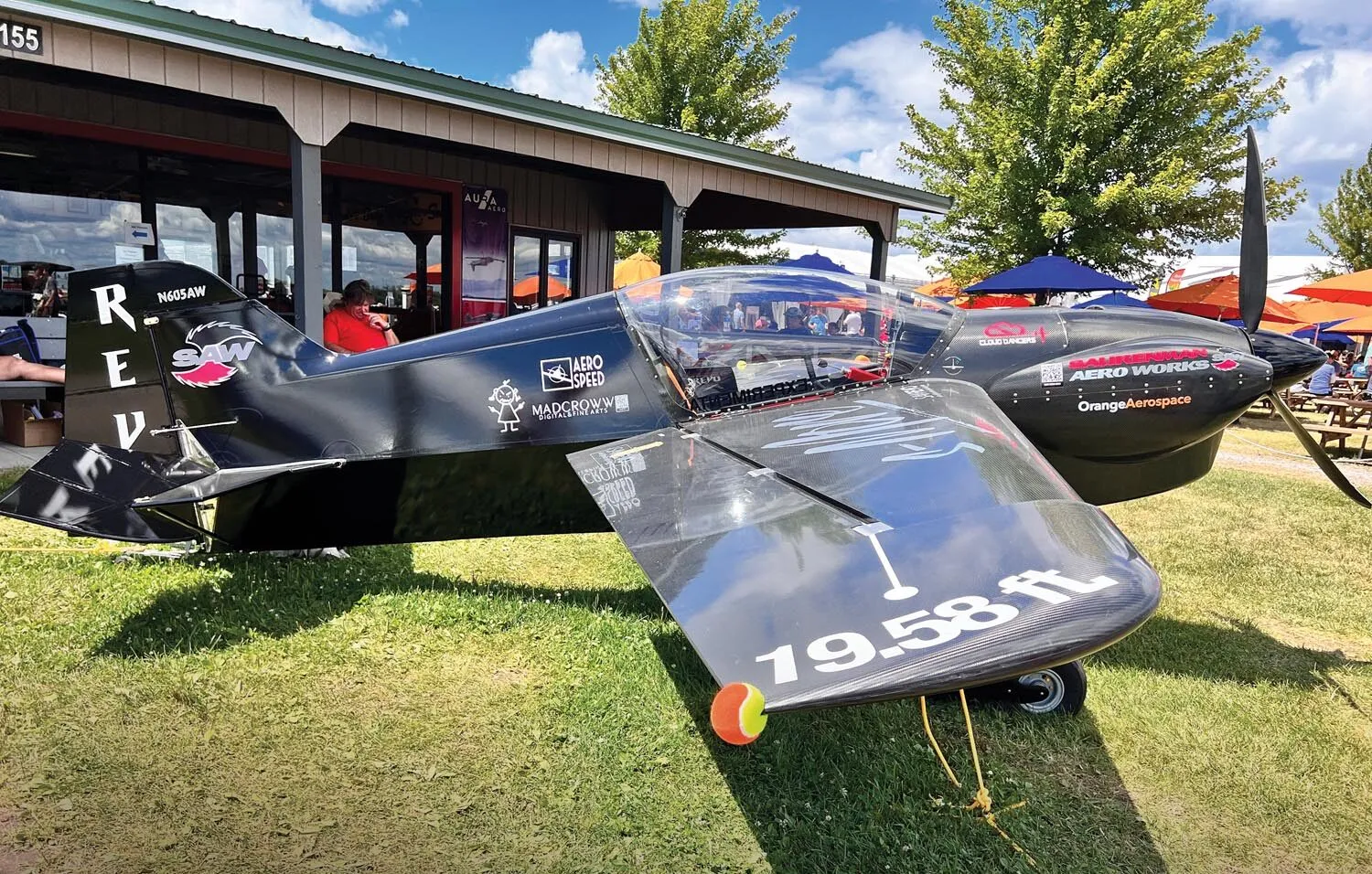
His journey through the world of aviation took off and he has never looked back. Flying at least several hours a day, Eddie amassed over 1200 hours in his Pitts Special by age 20. When he was 18, he began flying airshows with legendary airshow pilots like Jimmy and Steve Franklin, Marion and Duane Cole, Harold Newman and Bob Heuer, just to name a few. Eddie continues to have a flying family, which includes his daughter, Hanna, who has the unusual rating combination of glider as well as jet-powered motorglider certifications. His wife, Birdie, is also extensively involved in aviation and is the president of SAW and a huge part of the company.
Aside from just flying aircraft, Eddie was also involved in construction and design starting early in his life. His résumé is riddled with experience working at multiple major aerospace manufacturing companies, including Cessna, Beechcraft, Learjet, Raytheon, Bombardier, Helio Aircraft and Aviat. Starting at the low end of the totem pole deburring parts, Eddie learned the industry from the ground up and moved on to tooling, assembly, manufacturing and planning, scientific information systems, airframe and system design, and eventually aerodynamics and structural technical analysis. Through all of this, he never lost his love for aerobatic aircraft. Later he concentrated specifically in the design and modification of specialized aircraft. Many of these are flown by leading airshow pilots, such as Sean D. Tucker, John Klatt (Screamin’ Sasquatch jet-powered WACO), Kyle Franklin (Dracula), Skip Stewart (Prometheus), Jeff Boerboon (Yak 110—twin Yak 55 fuselages attached to a jet engine), Rich Goodwin (Jet Pitts S2S) and others.
In 2016 Eddie was awarded the Curtis Pitts Innovation Aerobatic Design Award. He is now designing independently and continues to push aircraft boundaries with the SAW Revolution carbon fiber biplane and his super-lightweight aerobatic monoplane design, the REVO.

The Vision
The idea of an inexpensive lightweight aerobatic airplane began about three decades ago when Eddie realized there still wasn’t an aircraft fitting this criteria. The REVO itself began life seven years ago as what his friends and family affectionately called “Eddie’s airplane.” His original thoughts leaned toward a very light (about 300 pounds) machine with a sling seat and power from a snowmobile engine. However, as interest grew, design creep set in and slowly Eddie increased the overall size, power and weight to its current design, which is still quite light at 527 pounds. Initially, it was a test bed to explore manufacturing ideas and test numbers, with the goal being the ability to produce and distribute a light, affordable and very capable aerobatic aircraft.
At the time the REVO began coming together, Eddie was working with Orange Aerospace in the Netherlands, and they collaborated on the steel-tube fuselage and all the composite work that led to the design of the carbon fiber cowl and wings. Originally, the plan was for the aircraft to be manufactured in collaboration with Orange Aerospace. This subsequently never came together given the costs as well as issues with transportation to and from Europe. However, the partnership is ongoing, with plans for Orange Aerospace to produce the composite components, while overall manufacturing will be controlled by SAW.
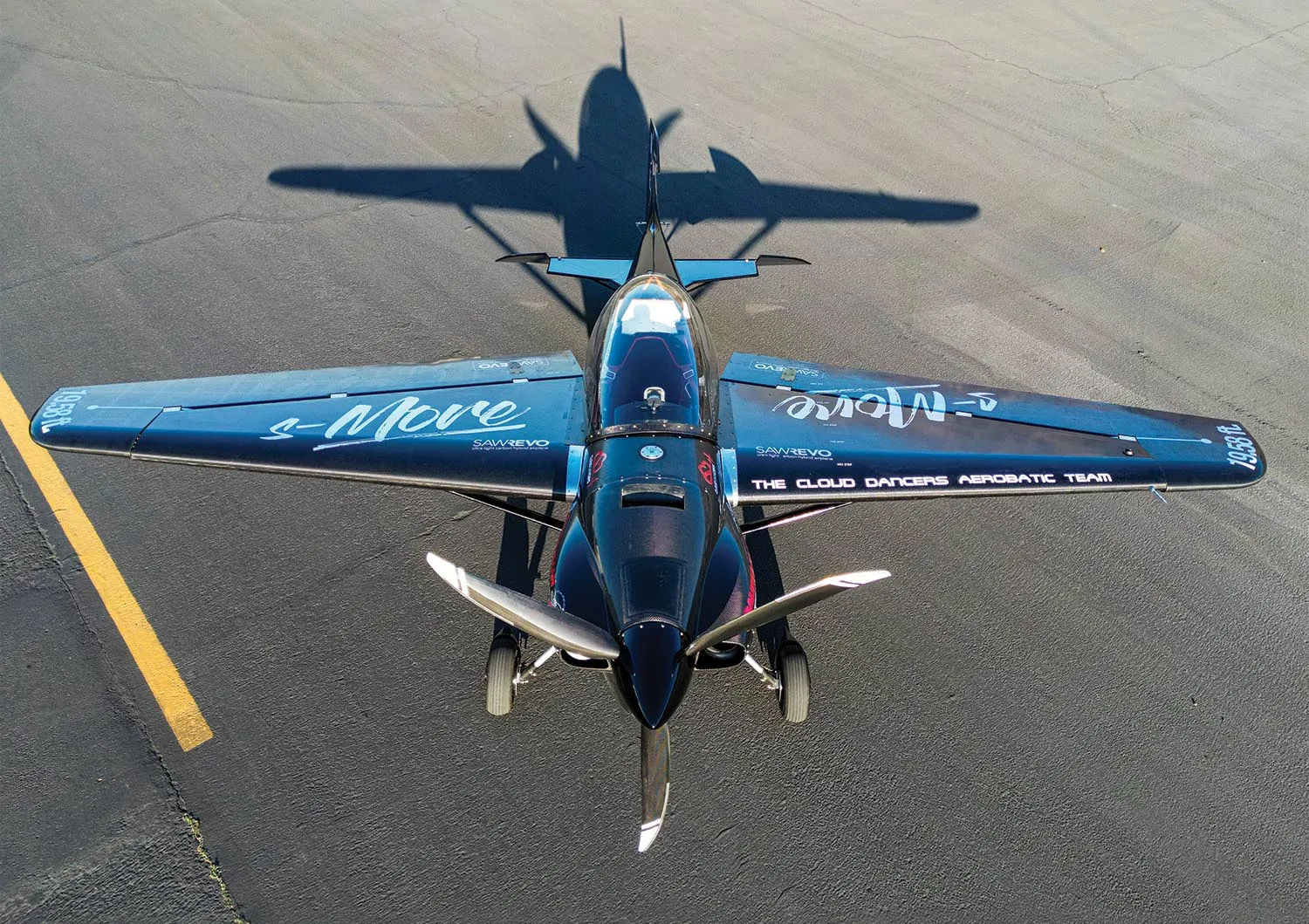
In addition to being an inexpensive and capable aerobatic mount, another goal for the REVO is to make it easy to build, with no stringers or formers and an “irreducible minimum” of parts. For example, eight bolts attach the control system to the tail feathers and three fasteners secure the turtle deck. Eddie describes a vision for builders to sit on the couch watching their favorite movies while applying fabric to the small aircraft. If using a waterborne, low- or no-odor fabric system such as Stewart Systems, this vision might be entirely viable!
The Machine
The fuselage is a pre-painted steel tube framework that ultimately gets covered with fabric. The current prototype wings are carbon fiber, with plans for kits to be offered with that option or fabric-covered wings with an aluminum structure. The current carbon fiber wings have a symmetrical airfoil, while the fabric-covered wings have a cambered airfoil and an additional nine square feet of surface area over the carbon fiber wings.
The aluminum structures are designed around an I-beam type front and rear spar and include drag/anti-drag wires and ribs. As prototype testing comes together and data is incorporated into the design, the next set of wings is anticipated to be 30 to 40 pounds lighter than the current set. While the carbon fiber symmetrical wings have what is tongue-in-cheek described as “Eddie’s snow-cone airfoil,” the airfoil of the fabric wings is an Eppler 361 design with a slight reflex to reduce the pitching coefficient to 0. The wing itself is a high-lift design, which of course means that it increases drag as speed increases. Control surfaces are activated by push-pull rods versus torque tubes. As the REVO moves forward, there will most likely be a symmetrical airfoil available with fabric wings, although this hasn’t been finalized yet.
While the airfare is small, it can accommodate pilots up to 6 feet 3 inches. Seat adjustments are accomplished by adding or removing cushions. The seat itself reclines at a 43° angle, which places the pilot’s knees and shoulders at the same level and increases the pilot’s G tolerance.
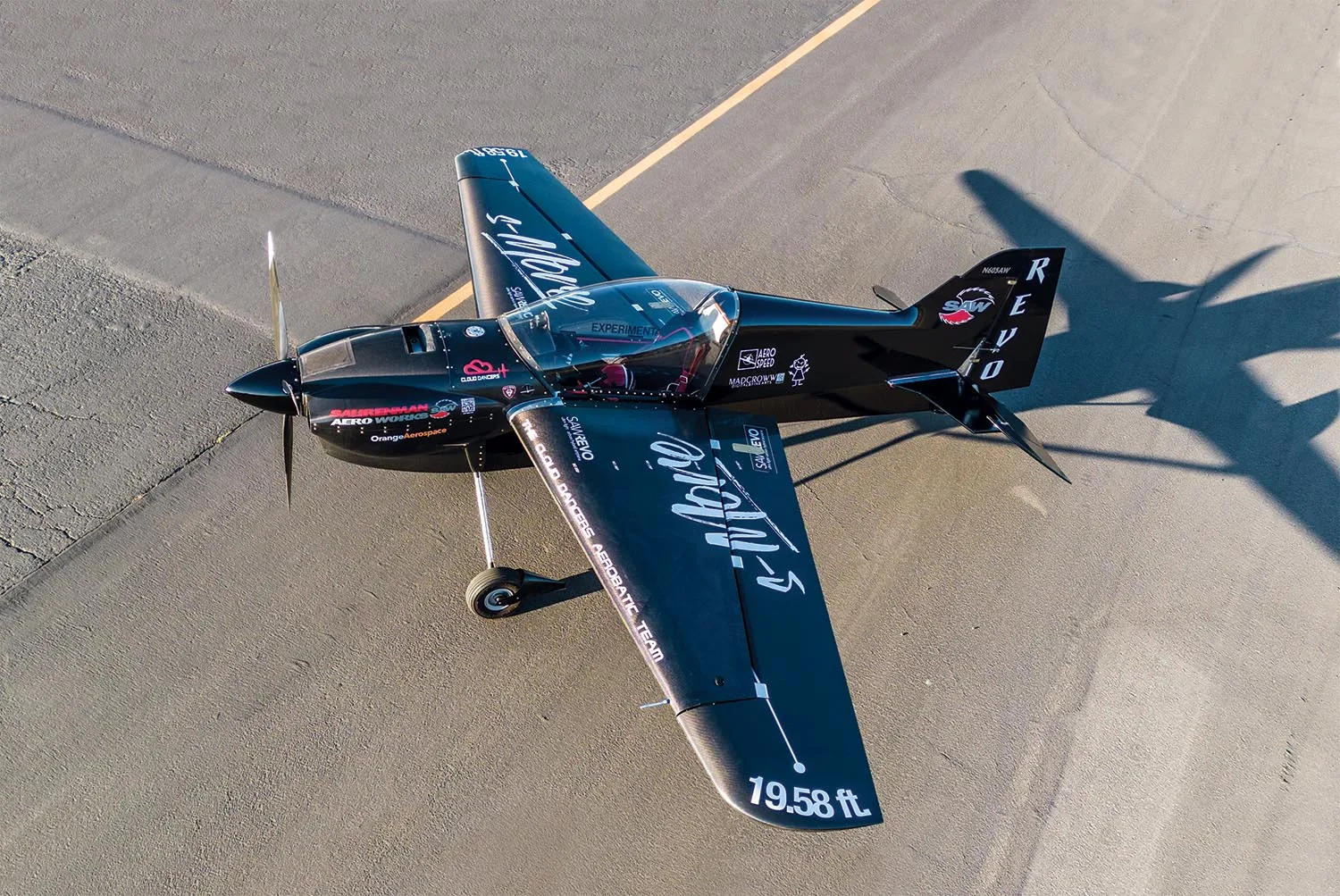
Getting into the stubby plane takes a moment to get used to. You back up to the leading edge of the wing on the left side, hike your derriere up onto the wing, slide back and spin around. The canopy is hinged to the right. Seated, you’re reclining as if you’re in your favorite chair. The controls move smoothly without any extra play through a full range of motion without hitting your knees. If you choose to add the ballistic parachute option, there isn’t the discomfort of sitting on a traditional aerobatic parachute pack for extended periods of time. The ballistic parachute also might inspire some to feel more comfortable with aerobatics.

The currently flying prototype is powered by a fuel-efficient 80-hp Rotax 912 and was planned to be a slow-speed aircraft with a cruise in the 100 mph range. However, as the envelope is further explored, the airspeed has been creeping up. After all, who doesn’t want more speed? Consideration is being given to other engines. As the cowling is currently configured, the Rotax as well as a ULPower engine can fit comfortably, making either engine a great option. A Continental O-200 could also fit but raises some weight and balance concerns and calculations.
The UL350iHPS is looking like the best powerplant combination for the REVO, and it has aerobatic approval in Europe. Inverted oil and fuel are already built into the engine, so the plumbing and valves are already in place and it’s air-cooled. The current version of the UL350iHPS produces 150 hp and weighs just under 200 pounds. The prototype aircraft is currently flying a with Whirl Wind fixed-pitch prop. However, for future versions Eddie would like to use a constant-speed propeller. Perhaps an electric constant-speed prop behind the ULPower engine?
For those interested in the overall engineering, flutter testing was performed utilizing finite element analysis. Also of note is that all design features of the REVO have flown on previous and current aircraft that Eddie has modified, been part of the design or has flown himself.
The REVO is very close to LSA standards with exception of the stall speed. However, given the increased wing area with the fabric wing, the projections are that it would be very close to LSA stall-speed requirements and may qualify for certification as an E-LSA. Time will tell, but it certainly would be fun to have a highly capable aerobatic craft within that category.
With the fuel tank in the fuselage, the aircraft will be easy to disassemble and trailer at the pilot’s preference. There’s a plan for a purpose-built trailer if the pilot decides down the road to transport the aircraft by ground. The trailer is envisioned to be something like a sailplane trailer, with stands and racks to store the fuselage and wings snugly and make assembly and disassembly manageable for a single person.
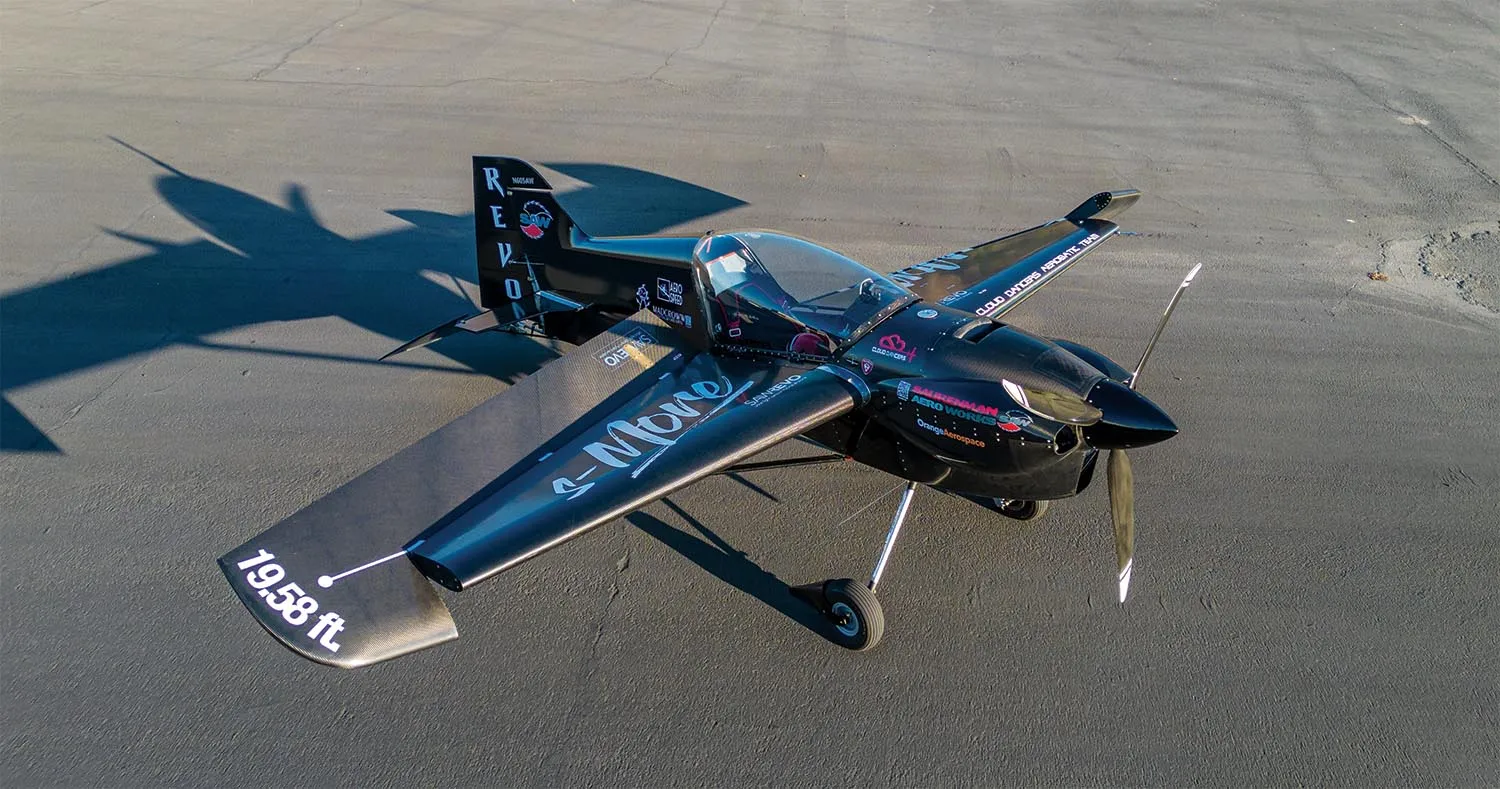
The Cloud Dancers
When the prototype took flight, it was located at the Saurenman facility in New Mexico. While the plane performed well, the decision was reached to move it closer to sea level to evaluate the aircraft without the density altitude component.
In entered Maurizio “Maz” Perissinotto. Maz is an Italian pilot who used to work for the airlines when not flying aerobatic airshow routines in his Pitts. He has logged over 4000 hours in 62 different types of aircraft and became involved with the REVO project several years ago.
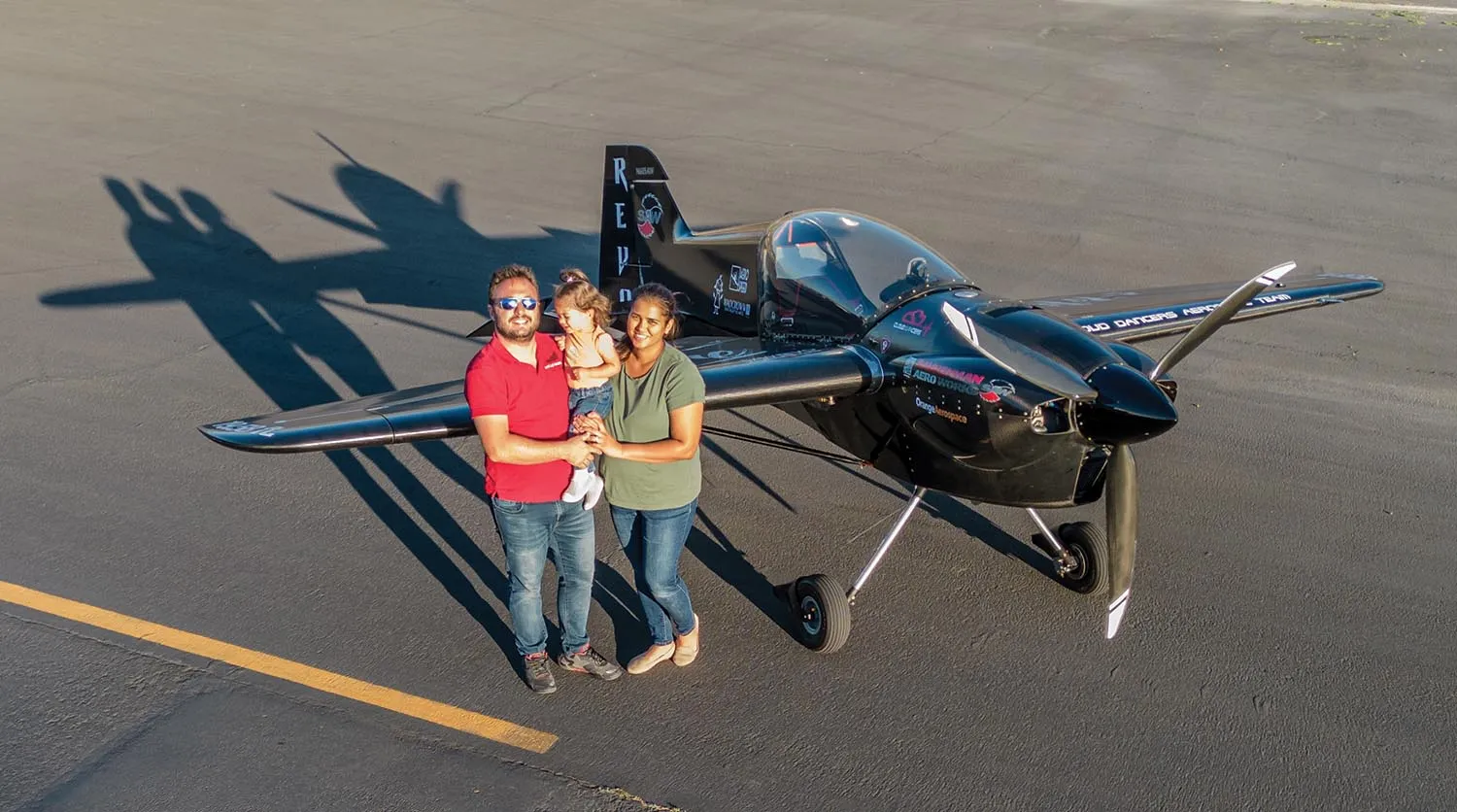
After immigrating to the U.S. three years ago, Maz moved to Santa Paula, California. He lives in a hangar home with his wife, Ruth Charlesworth Perissinotto (crew chief, private pilot and model), along with their young daughters. He and his wife are known as The Cloud Dancers and have displayed many exotic aircraft around the world since 2010. According to the Saurenman Aero Works website, “Maz is rated in ultralights, seaplanes, jets, aerobatics, high-performance singles, twins, electric and many Experimental aircraft in three continents.” Previously, he was flying a Bede BD-5J jet but now has a Hiperbipe called the Hiper Viper.
With the initial test flights of the REVO behind it, the prototype was moved to Maz’s hangar where he has been doing most of the test flying. Since then he’s been exploring the envelope of the new design. At the time of this writing, he’s logged around 75 hours in the prototype.
According to Maz, the view from the cockpit is unparalleled and the plane is a delight to fly, with no play in the pushrod-activated controls. The prototype is heavier than the planned production aircraft. However, even with the 80-hp Rotax engine, the initial climb is around 1800 feet per minute. It cruises around 110 knots in level flight but the prop is felt to require some re-pitching and higher cruise speeds are anticipated. Overall, Maz describes the REVO as feeling like a “light Pitts or similar to an RV-4,” and it is straightforward and quite manageable to take off and land, with ground handling that even a fairly low-time tailwheel pilot could manage. Tweaking continues as flight testing progresses. However, Maz is already building the Serial Number 2 aircraft, with the goal of flying behind the ULPower engine.

The Takeaway
Going back to our impressions of the mockup at Sun ’n Fun, the first thought looking at the V-shaped tube fuselage was “Hey, that’s clever!” Considering how the shape cuts down on fuselage size and weight, it makes obvious sense. We took note of the fighter-like, G-tolerant, leaned-back seat, thick high-lift wings and overall “cute-as-a-bug” appearance.
Another design element that sparks a lot of conversation is the seemingly oversized ailerons. While one person jokes, “I guess you’ll never complain about lack of aileron authority,” another is wondering if the ailerons will act as large speed brakes. With a roll rate of 400° per second at 120 mph, we think the latter argument is not likely to be a concern.
Needless to say, we were quite thrilled to see the REVO at AirVenture last summer, a little further along in its development. The single-seat mid-wing design with its bubble canopy appears to be vaguely reminiscent of a shrunken Yak 55. The minimalistic panel is appealing and everything about the REVO declares that it is meant to fly without extra frills or extraneous weight. It is a mission-specific aircraft, and a unique one at that.
The end goal of the REVO has always been to bridge the gap between the wallet and performance. While an Extra NG is north of $500,000, the price point for a completed REVO is expected to be $60,000 to $70,000, with the builder doing most of the work. The initial price of the kit is around $35,000. Of course, if you hire help to complete the avionics, painting, etc., the price will likely increase significantly.
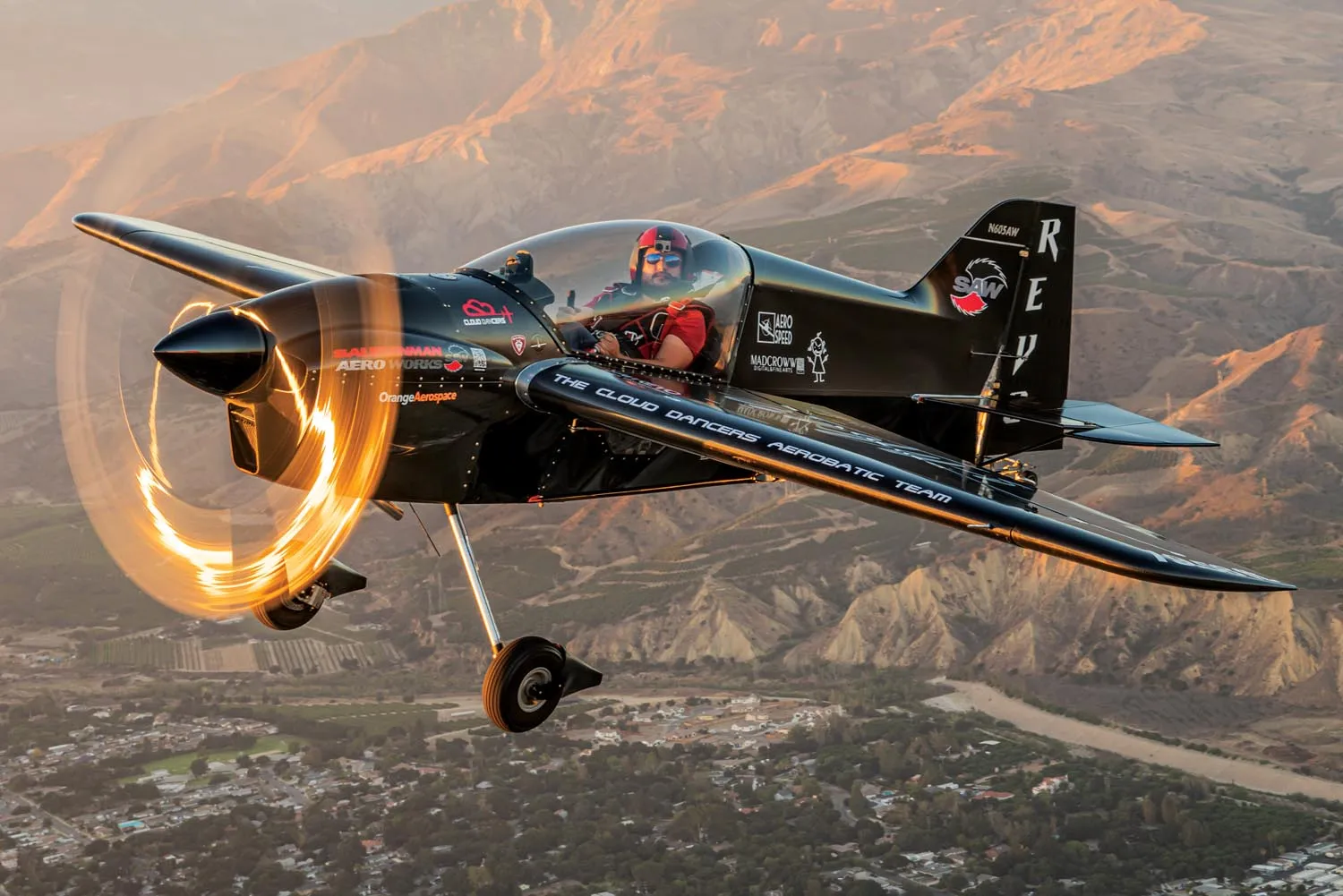
According to Eddie, “The objective is to deliver Extra performance at a fraction of the cost.” He suggests the REVO could easily be flown in the IAC Advanced category competitively and could possibly be flown in the Unlimited category.
Today’s aerobatic airplanes are economically out of reach for most young pilots, but a kit like the REVO could be a game changer. “If someone really wants to get into aero the way I did,” said Eddie, “the REVO gives them a way to do it. If it’s successful, it’ll create a new market without taking away from the current one.”
Summing up, the REVO offers aerobatic pilots superb visibility, excellent low-speed controllability and manageable ground handling in an airplane that is simple to build, fun to fly and economical to operate and maintain. Anticipated production dates for the first shipment of kits is the third quarter of 2023. For further information, check out the SAW website at sawcustomaero.com.
Photos: Evan Byrne and Jonathan and Julia Apfelbaum.





Ingen kommentarer:
Legg inn en kommentar
Merk: Bare medlemmer av denne bloggen kan legge inn en kommentar.